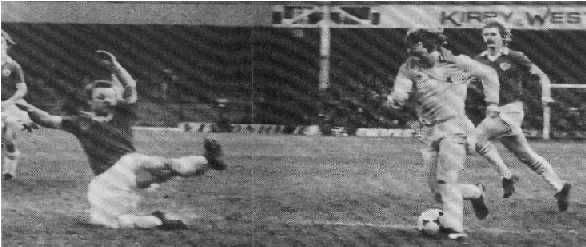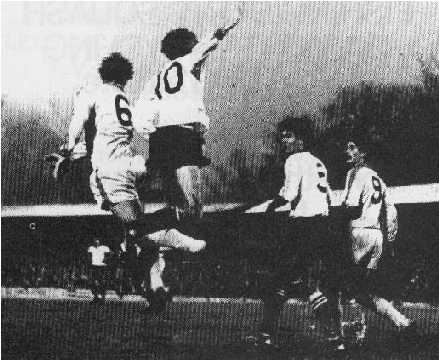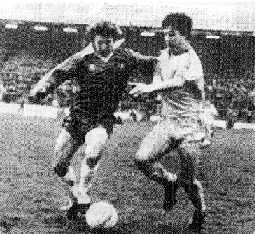Phil Whalley


Perhaps this is why so many footballers play out their careers in the familial surroundings of the football club which was responsible for their initial upbringing. Typically, the zenith of such a player's career has been played at a high level, but no longer wanted by the bigger clubs, he returns a slower, slightly fatter thirtysomething to his more modest footballing roots. Although cynics may scoff, I am inclined to regard this phenomena as a testament not just to the plainly human desire to feel wanted, but to the deep bonds of loyalty that take root when a football club successfully invests faith, time (and money) to carefully nurture a young man's ability.
In looking at some of Burnley's elderly returnees, I have to admit right away that they don't all fit the scenario I have just described, but this is partly due to the highly unusual nature of our recent history. I bet few clubs can match the Clarets when it comes to those who have played for the same club in the First and Fourth Divisions in different spells. While a number of players have turned out for Burnley in the three divisions outside the top flight, there exists (due to the spectacular scale of our fall from grace) a small elite who have played for the club in both the First and Fourth Divisions. Remarkably, two players have donned the Claret and Blue in all four divisions.
The first, and most obvious of this elite is Leighton James, who made his Burnley debut in November 1970, at home to Notts Forest. Although us younger Clarets never saw the fiery Welshman play for Burnley in the First Division, he did produce occasional moments of sublime brilliance during his second spell, most memorably his individual effort against Fulham at a snowbound Turf Moor (which had immediately followed a spat with a supporter in the Bob Lord Stand). Fortunately, the TV cameras captured the young Leighton at his best, brilliantly slamming in two thunderbolts at Kenilworth Road to single-handedly grab an away point for the Clarets in their promotion season of 1972-73.

I'm not sure what prompted Taffy to return for the fateful 1986-87 season, presumably the requests of a manager desperately short of resources had something to do with it. I expect that Clarets with memories long enough to remember James' rubbishing of the fans upon his first departure from Burnley will raise an eyebrow at the suggestion that his return was motivated by any sense of loyalty. It's certainly true that by the time of his third spell, James was overweight, slow and largely a spent force. Nevertheless, he still finished top scorer that season with 10 goals, none more important than a coolly-converted injury-time penalty to secure a precious point against Torquay.
Writing in the Burnley Express before the final home game against Orient, Jimmy McIlroy made it clear that he thought it would be James' final game for the Clarets - a reflection of James' declining fitness and Burnley's desperate need for new, younger players. Typically, Taffy battled on for two more seasons. One particular memory was his embarrassing sending-off on the opening day of the 88- 89 season after hilariously rugby-tackling a Rochdale player who was outpacing him for a through-ball. He never played another league game under Brian Miller after that incident, but was recalled in a sweeper role under Frank Casper. His final appearance for the Clarets was at the Turf in May 1989, nearly 19 years after his debut.
Much less can be said about two of the others in this group, although Billy Rodaway and Joe Jakub do have one unique piece of Claret and Blue history to their names. They hold the distinction of having played for the Clarets in all four divisions of the old Football League. All I can recall of Rodaway is him being a huge, unskilful central defender for whom no-one seemed to have a good word. He must have had something going for him though, as he made his debut in the 1971-72 season and was only released in 1981 - ten seasons later.

Rodaway's return in 1986 was as part of what must be the most reviled Burnley defensive line-up ever, including such luminaries as Joe Neenan (who, to his credit, did once bollock Tommy Hutchinson in front of the Longside), Peter Hampton, Phil Malley, Joe Gallacher, Darren Heesom and the spectacular debut/swansong of Tony Woodworth. I think the most fitting way to remember Billy Rodaway is not his contribution to the Burnley cause, but his role in the 80's cultural phenomenon that was Frankie Goes To Hollywood. Holly Johnson, lead singer of the said beat combo, revealed in his autobiography that he was first led down the road of homosexual showbiz debauchery due to his attraction for Billy Rodaway, "a strapping lad who played for Burnley," and whose poster adorned the wall of his sister's bedroom. So boys, when you don't want to come, think of Billy Rodaway. Unlike Big Bill, Joe Jakub was released in 1980 at the end of his first senior contract. Of this elite group of four, Jakub has the most tenuous membership, having made only one First Division appearance for the Clarets, and that in the very last game of the 75-76 relegation season. However, Jakub returned to establish himself as a first team regular, not missing a game for over two seasons.
The late-70's was a heady time for Burnley's young players, and Jakub (just slightly older than the future class of 81-82) found himself out in the cold as the likes of Kevin Young, Vince Overson and Phil Cavener started to progress through the ranks. Although a midfielder, Jakub was considered as a potential replacement for the ageing left-back Ian Brennan.

However, when the moment of truth arrived at the end of the 79-80 season, with the Clarets relegated to the Third Division for the first time ever, the management decided to buy Ian Wood from Oldham, and Jakub (along with another young left-back, Stuart McAdam) was out.
Jakub returned in 1989 and despite initial scepticism from some Clarets, he proved to be a solid, committed team member not without some value. Although employed as a hard-tackling midfielder by Frank Casper, Jakub was the subject of an early tactical switch by Jimmy Mullen, which proved a good solution to Burnley's problem position of left-back. Ray Deakin was well past his sell-by-date, but the young pretenders to the left-back place - Jason Hardy and Ian Bray - appeared not to be up to the required standard. Those present at the Turf in 1989 who saw Tranmere's Morrissey tear Hardy to ribbons were left in no doubt that Hardy wouldn't make the grade.
As a consistent and dependable left-back, Jakub enjoyed his most successful role at Burnley, and he must have particularly savoured the Fourth Division championship. Having never scored for Burnley in his first spell, he netted five in his first season back, including a crisp 20-yard winner against Carlisle on Boxing Day. Jakub lost his place to Iain Wilson halfway through the following season, and the little Scot bowed out at the Turf in April 1993, exactly 17 years after his First Division debut.
OK, so James, Rodaway and Jakub were easy to work out. What about the fourth one? None other than England International, Football League Championship winner, European Champions Cup winner and scorer of the 1981 goal-of-the-season: Tony Morley.
Perhaps its because he scored such memorable goals that I always think of Morley as a prolific goalscorer. In fact, he only ever scored seven league and cup goals for Burnley, so a Morley goal was a quite rare thing. Fortunately, the television cameras captured forever the fluidity and beauty of Morley in full, goalscoring flight. Firstly at Birmingham in the Cup on a freezing Tuesday night in January, finishing off a Clarets move with a scorching drive from 25 yards, and then that 1981 goal- of-the-season at Goodison Park, still wearing Claret and Blue, but alas, that of Aston Villa.
His Goodison effort was one of those goals that stays in the mind's eye: the deft flick to turn his marker, his close control while charging down the left at top speed, the cut inside and then that unstoppable drive into the top corner. Morley even managed to pull off a similar manoeuvre for England in their famous defeat of Hungary (which secured a World Cup Finals place in Spain), but put his shot too close to the keeper.
However, one piece of Morley magic was not recorded by the cameras, but will always be remembered by the 27,200 people present. Let me take you back to Boxing Day 1977. Burnley were languishing at the foot of the Second Division, while the Bastards from Ewood had pretensions in the promotion race. True to league form, Blackburn held a 3-0 lead, and halfway through the second-half were awarded a penalty. It was well-struck, but Stevo pulled off a tremendous save, diving to his right.
Suddenly, the Clarets were energised, none more so than Tony Morley. In a moment of brilliance, he put the Clarets back in the game. Taking possession on the left-wing, he cut inside, working his way across the penalty box and evading the lunges of the Blackburn defenders before unleashing a thunderous drive - a goal all the way. Piling forward, Burnley pulled another goal back but couldn't find the equaliser. I was seven years old at the time, and on only my third visit to the Turf I had witnessed a memorable goal.
It was a very different Burnley side to which Tony Morley returned in 1988. Peter Zelem wore Jim Thompson's No.5 shirt, Peter Daniel the No.2 of Keith Newton. Instead of Fletcher and Kindon, we had O'Connell and Comstive. Morley retained his No.11 shirt, but failed to make an impact. It's sad to note that a player of Morley's calibre, who had graced First Division venues like Molineux and Anfield in the Claret and Blue of Burnley, ended his Turf Moor playing days at Belle Vue, Doncaster in an abysmal 1-0 defeat in front of less than 3,000 people. Our memories of Tony Morley deserve a far better epitaph than that.
